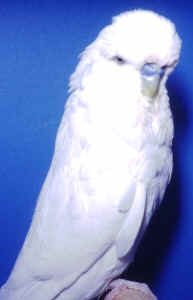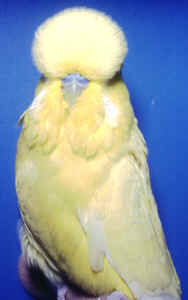
Double
Factor Spangles
By Ghalib Al-Nasser
Budgerigars Frank Silva
Photos by Terry A Tuxford

|
Double
Factor Spangles
|
|
WHEN the Spangle mutation was first established and found to be inheriting a dominant gene, it was not long before the Double Factor Spangle (DFS) was bred.
The history of the mutation, as related to us by that knowledgeable Australian John Scoble, first occurred in an aviary of Albert Ritchie, a fancier in Traralgon, Victoria, Australia who was breeding on the colony system. That initial stock was sold to another fancier from the same area, Melvyn Jones, who had established the variety by 1974. The original breeder confirmed that the mother of the first Spangle that he bred was a Black-Eyed White (White Dilute) hen. The father could have been a Dominant Pied split Recessive Pied who was occupying the same nest box with that hen. That fancier had many Recessive Pieds (called Harlequins in Australia). However, there are also reports to suggest that the mother was a Recessive Pied instead. The person who gave the variety its name was a well-respected judge from Victoria, Frank Gardner, because the bird, as far as the wing markings were concerned, resembled the Spangle pigeons that he had kept earlier.
A new story was related to us recently regarding the origin of the Spangle. This came from an interview conducted in July 2000, with Melvyn Jones, the breeder who established the variety, who was in his late seventies, just before he passed away.
Merv, as known to his friends, recounted how his mate, Albert Ritchie, who lived over the back fence, bred canaries and budgies. Albert was interested in breeding Lutino budgies, which Merv had. "On our way to work one morning, he just happened to mention that he had bred this budgie chick which was just out of the nest and was a funny colour. He didn’t like it and was going to take it, its brother and parents to the pet shop because he was after Lutinos". Merv went around after work and Albert showed him the chick, a yellow face with a funny wing marking. There were two chicks, the brother was a washed out, limy green colour. The father of the chicks was also a washed out, limy green colour, like the son. Merv then bought the father and the two sons off Albert for pet shop price $2 each. Merv recalled that the mother was a skyblue hen.
The description given above of the father and the two sons gave us the clue that they were of the single factor mutant 2 Yellowface, hence the description of the limy green. It now gives the indication that the funny coloured wing baby was actually a Spangle Yellowface Single Factor Mutant 2 Blue cock. The fancy was extremely lucky that a chance conversation on the bus between Albert and Merv, on the way to work had taken place. As Merv said, "If they had been sent to the pet shop, they would have been lost! Someone would have bought them, put them in a small cage and that would have been that."
Luck also played a part in the next turn of events. Unfortunately, Merv lost the original father and his look-alike son before he was able to breed with them. As luck would have it, he was left with this "yellowface with the funny wing markings". Having only this bird to breed with, and it was only a baby when he bought it, Merv said, "it took a long time to get things going and I had to breed them to different things. I didn’t have enough of them to breed Spangle to Spangle. Merv was not into budgie genetics and was quite forthright. "I didn’t understand some birds split and some didn’t. I just thought a budgie was a budgie! I didn’t understand that when I bred them to a normal you got half Spangle and half normal!" How lucky were we that Merv’s liking for the colour of the variety and the fact that it was a dominant variety meant he kept producing them. I’m sure if they were a recessive variety, they would have been lost. Merv went on to say, "As I went forward, I bred more and more and when I bred Spangle to Spangle that’s when I got these black-eye whites and yellows out of them!"
The interview drew the conclusion that the first breeding season with this Spangle Yellowface was in 1974, making 1973 the year the initial Spangle Yellowface was hatched in the aviary of Albert Ritchie. This was in fact the birth of the Spangle variety. Albert had bought the two parent birds from a pet shop and their background was unknown. From the description Merv had given we are certain neither of the parents were Spangles.
With the Spangle chick born in 1973, we could assume he would not breed until 1974. Breeding all year round, as Merv said he did, he could only breed Spangles from the one cock during the first year. In 1975 the Spangle progeny would be paired to both normals and each other to increase numbers quickly. Merv had 60 odd Spangles in the flight before he sought help to recognise the variety. Some of these were the ‘black-eyed’ Double Factors. I would suggest it was in 1976 that this variety was first recognised as a new mutation. This all ties into the fact that 1976 was the recognition of a "new mutation" and 1973 was its year of "birth".
A few years later, June 1980, a young Swiss, Rolf Christen, took some of these birds with him from Australia, where he was residing, to Switzerland when visiting his parents. The consignment was of 12 birds and consisted of 4 Clearwings and 8 Spangles (7 cocks, one of which was a double factor and a hen). He bred with them in October that year. He then sold one pair to Joe Mannes and sold the rest with records and babies to Reinhard Molkentin in Germany before his return to Australia in March 1981. Both Alf and Doug Sadler were able to obtain this variety and bring it to the U.K. in about 1982. Doug's source was from his German friend Reinhard. Although there are claims and counter claims as to their origin and their arrival in England, from our point of view it does not matter a great deal.
Now, coming back to the DFS I have always wondered why, when pairing two SFS, birds with body colour melanin produce a clear bird. The genetics is not that straight forward. Here we have a co-dominant mutation with SF producing half the effect of the DF. This means that the real action of the spangle gene is reflected by the DF phenotype, rather than the SF phenotype. Here, the process of melanin production is lost tending towards a "clear" plumage pattern, that is one devoid of melanin but retaining the ground colour (yellow or white pigment).
DFS are produced from 3 different mating:
1. SFS x SFS gives 25% DFS
2. SFS x DFS gives 50% DFS
3. DFS x DFS gives 100% DFS
I have always liked the DFS and many of our spangle pairings are to produce the DFS. I have found that using DFS enhance the SF spangle wing markings, something that we seem to have lost with our spangles.
The BS Colour Standards for the DFS Yellow requires that the body colour be free from any odd green feathers or green suffusion is the ideal but slight collar of colour round the neck is acceptable and the same applies to the DFS White.
The BS Scale of Points for the DFS allocates 60 points for the size, shape including size of head and 40 points for colour. Here comes the art of judging this variety whereby how many points should be deducted from the 40 points allocated for colour should the bird have too much green/blue suffusion in the body and wings?
Often fanciers ask the question "How can you judge a SFS against a DFS as the DFS are always going to be penalised against the SFS because of the lack of marking." I do not see it that way at all because my answer has always been that we have to judge 19 different colour categories in a section line up of 38 first class winners in cocks and hens at championship shows. It does not prevent us from putting a Lutino best in section neither a DFS for that matter.
DFS have done well on the show bench over many years, winning CCs and BISs. When I wrote the SBBA Handbook in 1996 I stated on page 29 that the first DFS to win a CC was at the 1992 BW show won by Sue & Rod Clarke. I claim the credit to have been the judge to give that award. I also stated that Frank Silva was the first to win BIS with a DFS at the Essex Supreme championship show in 1996. No one who read the Handbook refuted my claim for the DFS CC, but both Ramsay Eggie claimed that he first won a BIS with a DFS at the 1995 Forth Valley BS championship show just to be refuted again by Bill Miller who won the same award at the same show the previous year.
From the 1997 show season classes for DFS were introduced at the 10 area championship shows and the BS Club Show. DFS classes were included at specialist & rare type shows much before that. Although there may be a strong case for classes for DFS to be introduced at all shows and even to have their own CC, we SBBA members, must do our part to warrant these additions. We need to support the DFS classes at area shows as well as specialist & rare variety type shows. I will always remember judging the spangles at one area society show recently just to have NO DFS entered in the show at all. This unfortunately does not encourage me to campaign hard for the variety to have their own CC. It is up to us to support the DFS at shows and up to us to breed more of them for their beauty as well as their size. My advice to those who breed spangles will be to breed DFS and show them as well.
Copyright © Ghalib Al-Nasser 2003 all rights reserved.